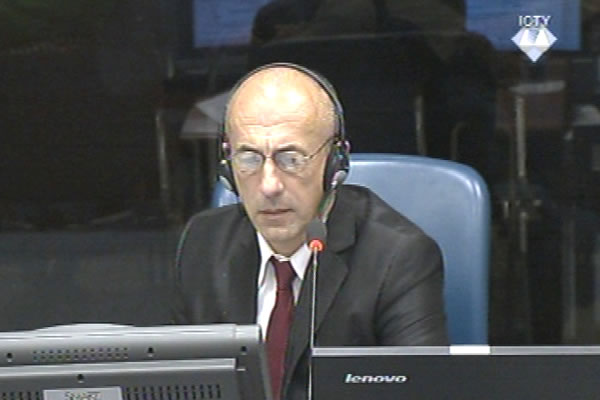Home
WITNESS KNOWS NOTHING ABOUT CRIMES OF HIS FELLOW FIGHTERS
Ranko Kolar, former officer in the VRS 6th Sana Brigade, described in detail the crimes against Serbs in the village of Kravica region in Eastern Bosnia regardless of the fact that he was there only for a short time, to support the local units. On the other hand, the witness didn’t know anything about the crimes against Muslim civilians in Sanski Most where he spent almost the entire war
 Ranko Kolar, defence witness at Rako Mladic trial
Ranko Kolar, defence witness at Rako Mladic trial After a former employee of the BH State Security Service Nedjo Vlaski completed his evidence, Ratko Mladic’s defense called Ranko Kolar to the witness stand. During the war in BH Kolar held several command posts in the 6th Sana Brigade. He was a company commander until November 1992, when he was promoted to the post of a battalion commander. When the war ended, he was chief of staff in the brigade.
In the statement to the defense team the witness said that his unit was engaged in various combat operations in the Sanski Most region with occasional excursions to the Bihac battlefield and Eastern Bosnia. According to the witness, he was there in January 1993 and he witnessed an attack launched by Naser Oric’s units on Serb villages, including Kravica. Kolar saw the ‘first echelon’ troops enter the villages. They were followed by the ‘second echelon’. As the witness recounted, the second echelon seemed somewhat disorganized, and those people focused on stealing food from houses that were later burned down.
In the cross-examination, prosecutor Jeremy once again probed the issue of the crimes in Sanski Most where the witness had spent most of the war. The prosecutor asked the witness if he knew that Serb soldiers had killed 25 civilians in the village of Hrustovo on 31 May 1992. A pregnant woman and several children were among the victims. Kolar said he had arrived in the Hrustovo region with his unit two days after the incident. According to Kolar, he didn’t learn about the crime then and there, but later, from the media.
The prosecutor showed a Sanski Most police report from August 1992. The document stated that three ‘collection and investigation centers’ had already been set up in the municipality. One was located in the sports hall, another in Betonirka hall, and the third in the Krings Factory. Kolar heard that captured Muslim and Croat soldiers were taken there, but he never heard about any civilians being put in those camps.
The prosecutor pressed the issue, noting that a Serb soldier by the name of Danilusko Kajtaz was sentenced to a long prison sentence by the BH State Court for a crime he committed on 7 July 1992, when 19 Muslim civilians suffocated in a truck as they were being transported from Betonirka to the Manjaca prison camp. In the meantime Kajtaz changed his name to Nikola Kovacevic. Kolar didn’t know much about the crime either, apart from the fact that he heard Kajtaz was convicted of something. Although they were members of the same brigade in Sanski Most, Kolar claimed that he never heard about Kajtaz until after the war.
Finally, the prosecutor noted that in 1992 the witness’s unit was stationed in the area of the village of Krkojevci near the confluence of the Dabar and Sava rivers. After the war, a mass grave containing 19 bodies was discovered there. On 7 July 1992, the victims suffocated at that site en route to Manjaca. The witness said he had not heard about the mass grave before. The mouth of the Dabar river was two whole kilometers away from the position of his unit in Krkojevci, the witness added.
As today’s hearing drew to a close, Savo Bojanovic began his testimony in Mladic’s defense. During the war Bojanovic was a judge in the military court in Bijeljina.
Linked Reports
- Case : Mladic
- 2014-11-04 SERBS SECEDED FROM BH BECAUSE THEY WERE ‘HUMILIATED AND OUTVOTED’
- 2014-11-03 CIVILIANS WARNED TO KEEP AWAY AS VLASENICA MOSQUE WAS BLOWN UP
- 2014-10-30 WAR STORIES FROM FOCA HOSPITAL
- 2014-11-06 HOW MILITARY COURT PROSECUTED SERBS IN BIJELJINA
- 2014-11-10 BLAMING THE ‘OTHER SIDE’
- 2014-11-11 ‘SERB’ OR ‘INDEPENDENT’ AUTONOMOUS REGIONS?
